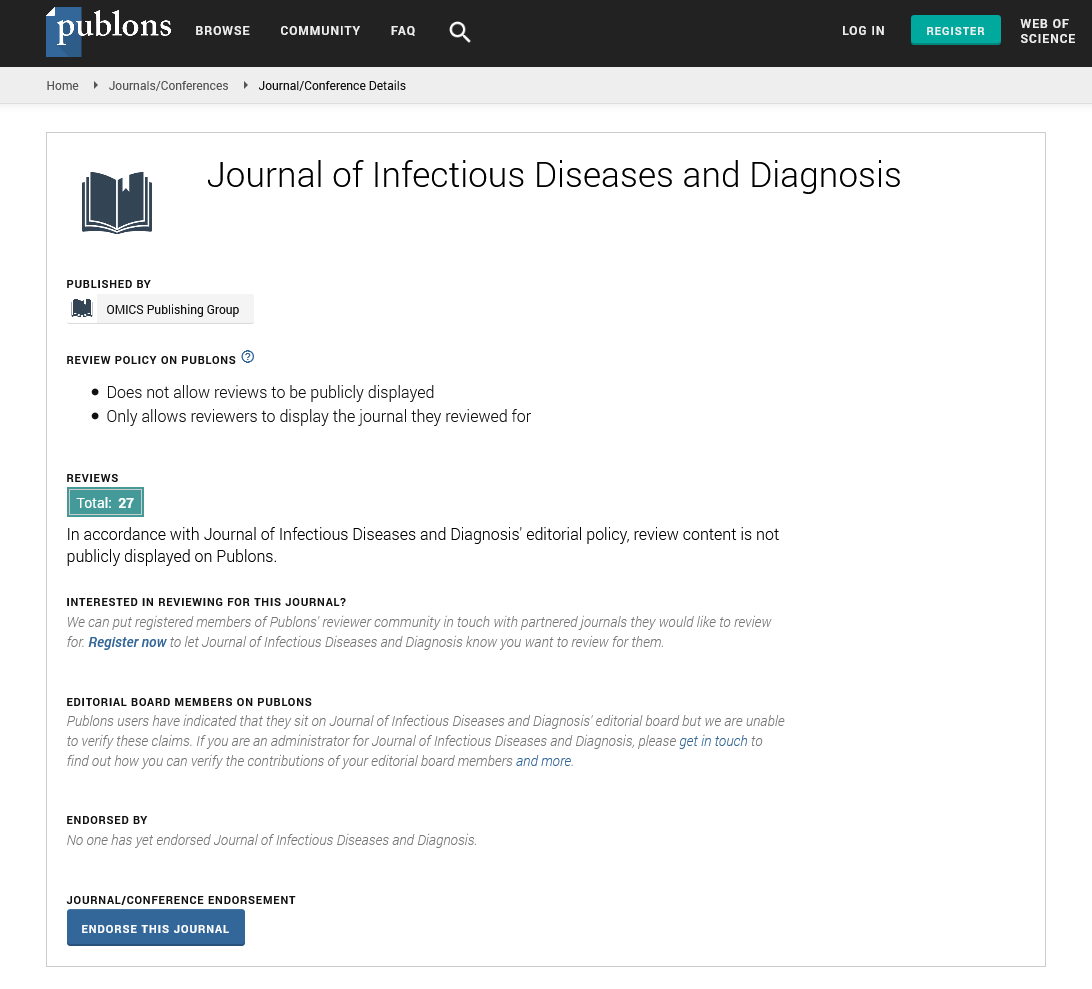Indexed In
- RefSeek
- Hamdard University
- EBSCO A-Z
- Publons
- Euro Pub
- Google Scholar
Useful Links
Share This Page
Journal Flyer

Open Access Journals
- Agri and Aquaculture
- Biochemistry
- Bioinformatics & Systems Biology
- Business & Management
- Chemistry
- Clinical Sciences
- Engineering
- Food & Nutrition
- General Science
- Genetics & Molecular Biology
- Immunology & Microbiology
- Medical Sciences
- Neuroscience & Psychology
- Nursing & Health Care
- Pharmaceutical Sciences
Commentary - (2025) Volume 10, Issue 5
Comprehensive Overview of Diagnostic Strategies for Human Swine Influenza Infections
Olivia Kent*Received: 29-Aug-2025, Manuscript No. JIDD-25-30290; Editor assigned: 01-Sep-2025, Pre QC No. JIDD-25-30290 (PQ); Reviewed: 15-Sep-2025, QC No. JIDD-25-30290; Revised: 22-Sep-2025, Manuscript No. JIDD-25-30290 (R); Published: 30-Sep-2025, DOI: 10.35248/2576-389X.25.10.349
Description
Swine influenza virus infections in humans have been a public health concern since the early 2000s due to their ability to spread rapidly and occasionally cause severe illness. Detecting the virus in its early stages is essential for reducing transmission and improving patient outcomes. Although symptoms often resemble those of seasonal influenza, careful assessment is required because some individuals may experience rapid deterioration, especially those with underlying medical conditions. Fever, fatigue, sore throat, cough and muscle pain are common manifestations, while gastrointestinal disturbances may also occur in certain cases. Correctly identifying the virus is essential to differentiate it from other respiratory infections and guide appropriate treatment.
Clinical evaluation is typically the first step in recognizing possible infection. Physicians consider both the pattern and duration of symptoms and recent exposure to pigs or environments where swine influenza outbreaks have occurred. However, clinical observation alone is insufficient for confirming infection because symptoms overlap with numerous other viral illnesses. Laboratory-based diagnostics provide the most reliable confirmation. Among these, antigen detection tests are often used for rapid screening. These tests rely on detecting specific proteins from the virus present in respiratory secretions. While they provide quick results, their sensitivity is lower than molecular methods and negative results may require additional testing to exclude infection.
Several laboratory-based diagnostic methods are widely used to confirm swine influenza, with a primary focus on detecting viral components or host immune responses. These approaches help differentiate between circulating strains, which is essential for understanding outbreak epidemiology. Samples are usually collected using nasal or throat swabs, and careful handling is required to avoid contamination and ensure accurate results. Laboratories conducting these analyses must follow standardized procedures to maintain consistency and reliability. While these diagnostic tools offer strong performance, their availability may still be limited in regions lacking advanced infrastructure or trained personnel.
Serological testing provides another avenue for identifying infection. By detecting antibodies against the virus, these tests can determine whether an individual has been previously exposed. While they are not suitable for detecting early-stage infections, they are helpful for assessing immunity in populations and evaluating the reach of outbreaks. This type of testing also assists in research, including studies on vaccine efficacy and immune response over time. Viral culture, although less commonly used in routine diagnosis due to its labour-intensive nature, remains important for understanding virus behaviour and testing potential treatments. Culturing the virus requires strict laboratory safety procedures, which ensures that research and diagnostic work can proceed without risk of accidental transmission.
New diagnostic methods are improving the speed and simplicity of detecting swine influenza. Biosensor-based systems and microfluidic platforms are being evaluated for their ability to provide rapid, dependable results with minimal laboratory involvement. Immunoassay techniques are also showing usefulness in both clinical and remote settings for identifying infections. Together, these technologies help reduce diagnostic delays, allowing faster responses and more effective implementation of control measures.
Surveillance plays a complementary role in controlling swine influenza. Regular monitoring of swine populations and human cases allows health authorities to detect changes in infection patterns. Collaboration between veterinary and human health sectors is essential because the virus can move between species. Early detection facilitates timely measures such as isolation, patient monitoring and the application of preventive protocols, including vaccination campaigns when appropriate. Public education also enhances early reporting, as individuals who recognize symptoms and seek medical attention promptly contribute to the containment of outbreaks.
Challenges in diagnosis remain, particularly in regions with limited laboratory infrastructure or scarce medical resources. Access to molecular testing is uneven and delays in specimen transport or result reporting can impact timely identification. The virus may also undergo genetic changes that affect the accuracy of existing assays, necessitating continuous evaluation and updates of testing protocols. Community awareness and access to healthcare are therefore critical components of successful infection management.
In conclusion, the detection of swine influenza relies on a combination of careful clinical observation, laboratory testing and epidemiological monitoring. Rapid antigen tests, RT-PCR, serological assays and viral culture all provide valuable information, each serving distinct purposes. Innovative diagnostic technologies show promise for increasing accessibility and efficiency, but challenges related to infrastructure, virus variability and resource availability persist. Strengthening collaboration between healthcare sectors, investing in diagnostic development and promoting public awareness are essential to identify infections promptly and limit their impact on human and animal health.
Citation: Kent O (2025). Comprehensive Overview of Diagnostic Strategies for Human Swine Influenza Infections. J Infect Dis Diagn. 10:349.
Copyright: © 2025 Kent O. This is an open-access article distributed under the terms of the Creative Commons Attribution License, which permits unrestricted use, distribution and reproduction in any medium, provided the original author and source are credited.

